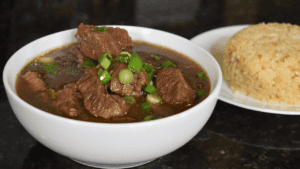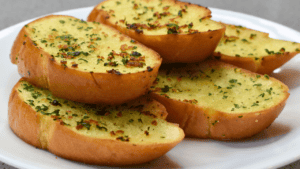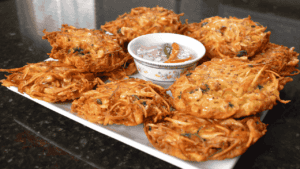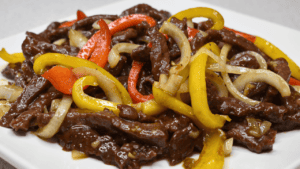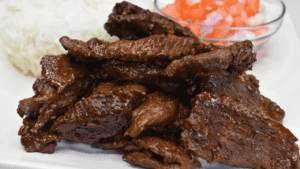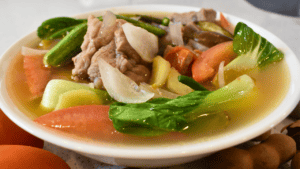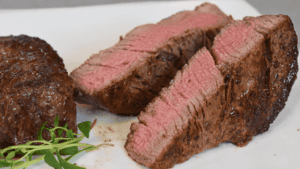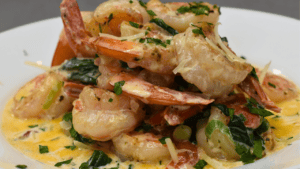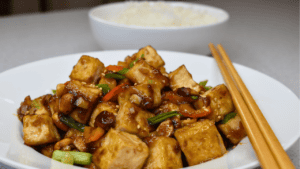Kamote Que
Kamote Que, also known as camote cue or sweet potato fritters, is a popular snack in the Philippines. It is made by deep-frying slices of sweet potatoes coated in brown sugar and skewered on bamboo sticks.
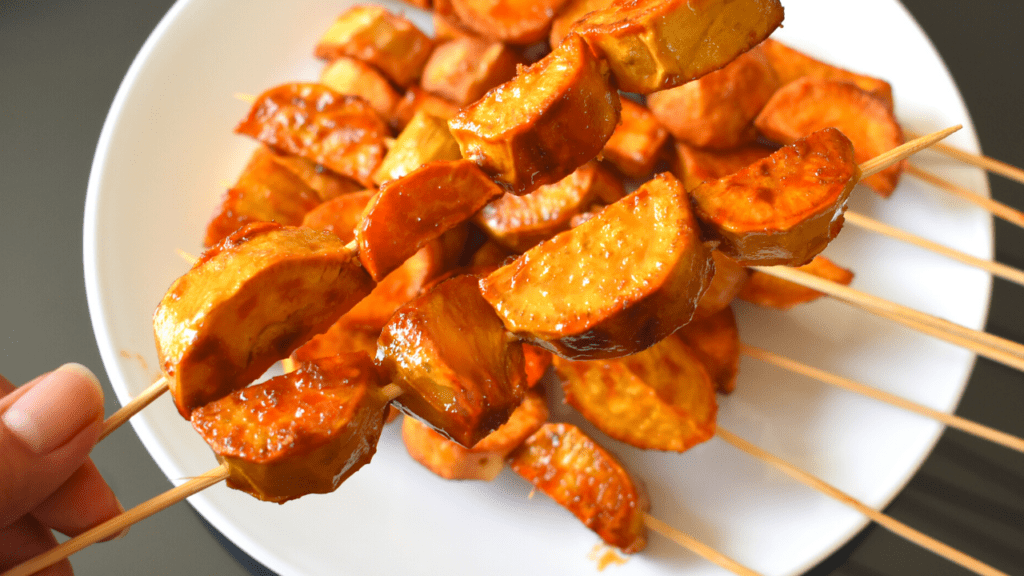
Kamote Que: A Sweet Potato Delight
In the bustling streets of the Philippines, the aroma of caramelizing brown sugar and frying sweet potatoes captivates passersby. This beloved street food, Kamote Que, is a delightful combination of sweet and savory, a taste of Filipino culinary artistry. For those who cherish the rich tapestry of Filipino cuisine, or simply have a hankering for some street food flair, learning to make Kamote Que at home is a must-try experience.
In this blog post, we will explore the ins and outs of this much-loved street treat, from its origins in the Philippines to the sweet and crunchy perfection that results from proper preparation. Get ready to infuse your kitchen with the scents and flavors of the Philippines as we celebrate Kamote Que, the sweet potato delight.
Kamote Que Unveiled
Kamote Que, also known as “candied sweet potatoes,” is a popular Filipino street food made with sweet potatoes, brown sugar, and deep-fried to perfection. The name’s origin is a blend of Spanish and Tagalog, with “que” referring to caramelized sugar, and “kamote” being Tagalog for sweet potato.
Filipino cuisine enthusiasts and connoisseurs of street food will find this blog post a treasure trove of information and tips for making the perfect Kamote Que. We’ll start by unraveling the mystery of this mouthwatering dish and move into the kitchen where we’ll concoct the authentic and scrumptious recipe.
Recipe: Sweet Potato Bites
Ingredients needed
For the main dish
- 2 lbs sweet potatoes, chopped into bite-sized pieces
- 1 cup cooking oil
- 1 cup brown sugar
Step-by-Step Instructions on How to Make Kamote Que
Peeling and cutting sweet potatoes
Start by thoroughly washing and peeling your sweet potatoes. Keep in mind the color of the sweet potato is not necessarily a good indicator of the sweetness. Liberally chop them into bite-sized, 1-inch cubes. The size is important for a quick and even fry.
Frying process with oil
Heat the oil in a wide, heavy-bottomed frying pan over medium-high heat. Test the oil by dropping in a small piece of sweet potato – it should sizzle immediately. Once the oil is ready, carefully add the sweet potatoes, being cautious not to overcrowd the pan to avoid lowering the oil temperature too much.
Caramelizing with brown sugar
Fry the sweet potatoes until beautifully golden brown. This step is the most critical, as this initial frying determines the texture of the final product. Once the sweet potatoes are almost fully cooked, sprinkle brown sugar over them, turning the pieces with tongs or a slotted spoon to ensure an even coat. The sugar will melt and caramelize, creating a luscious glaze.
Serving Suggestions
Kamote Que is typically served straight from the pan, hot and crispy. However, for presentation, you can skewer a few pieces on bamboo sticks. This not only looks great but gives you a handle to enjoy your sweet potato bites.
Why Kamote Que?
The Cultural Significance
Kamote Que is a nod to Filipino resilience and creativity. With sweet potatoes being a staple ingredient, this dish brings warmth and a sense of community. It is a fixture in Philippine fiestas and a much-anticipated treat for children and adults alike. Street vendors selling Kamote Que are an integral part of the Filipino culinary experience, providing nourishment and joy to all who indulge.
Versatility and Flavor Profile
The versatility of Kamote Que lies in its simplicity. The earthy sweetness of the sweet potatoes complements the rich caramel flavor from the sugar, creating a multidimensional taste. While delicious as a standalone snack, Kamote Que can also be part of a larger meal, adding a sweet element to contrast savory Filipino dishes like adobo or sinigang.
Health Benefits of Sweet Potatoes
Nutritional Value and Benefits
Sweet potatoes are a superfood, packed with vitamins A and C, fiber, antioxidants, and a low glycemic index that’s good for diabetics. This makes Kamote Que not only a delightful treat but a somewhat healthier indulgence than deep-fried regular potatoes.
The Healthier Alternative to Regular Potatoes
Compared to white potatoes, sweet potatoes offer more nutrients and fewer carbs. They also have less starch, which means they can be more satisfying with smaller portions. This makes Kamote Que a great choice for those looking to manage their weight and overall health while still enjoying great food.
Conclusion
Kamote Que is more than just a street food; it’s a celebration of flavor, culture, and community. With its sweet and crispy allure, this delightful dish can elevate any meal or serve as the star of your snacking tableau.
Encouraging readers to roll up their sleeves and try their hand at making Kamote Que at home is the ultimate goal of this blog post. The satisfaction of creating a Filipino favorite in your very own kitchen is an experience that’s second to none. Serve it to your family and friends, and watch their faces light up with the pure joy that only food can bring.
The next time you’re craving something sweet, reach for a sweet potato, some brown sugar, and a pan. Cook up a batch of Kamote Que to immerse yourself in the rich, delightful experience of Filipino street food.
Don’t hesitate to share your thoughts and experiences with us. Try the recipe and drop a comment below; we’d love to hear how your Kamote Que turned out!
Kamote Que Frequently Asked Questions
What is kamote cue?
Kamote cue is a popular street food in the Philippines. It is made by coating sliced sweet potatoes (kamote) with brown sugar and deep-frying them until they are caramelized.
Is kamote que healthy?
While kamote cue may be delicious and satisfying, it is not considered to be a particularly healthy snack due to its high sugar and fat content from the frying process. However, swapping out white sugar for healthier alternatives like honey or coconut sugar can make it slightly more nutritious.
How many calories in a kamote que?
The number of calories in a serving of kamote cue varies depending on the size of the sweet potato and amount of oil used for frying. On average, one piece may contain around 200-300 calories.
What is the English name for kamote?
In English, kamote is known as “sweet potato,” although there are many different varieties of sweet potatoes that vary in color, texture, and taste.
Is kamote native to the Philippines?
Kamote, or sweet potato, originated from Central America but has been grown in the Philippines for hundreds of years. It is now considered a staple crop in Filipino cuisine due to its versatility and availability throughout the year.
Why is kamote famous in the Philippines?
Kamote has become famous in the Philippines not only because it is a staple food but also because it can be prepared in various ways such as boiled, fried, mashed or even turned into desserts like cassava cake or turon (fried spring rolls).
What is the most eaten fruit in the Philippines?
The most eaten fruit in the Philippines is actually bananas. Other popular fruits include mangoes, pineapples, papayas,and coconuts.
What does kamote mean in Filipino?
In Filipino language (Tagalog), kamote means “sweet potato.” However colloquially,it can also mean “stupid” when used as an insult towards someone’s intelligence.
Why is Filipino food always sweet?
Filipino cuisine often incorporates elements of both savory and sweet flavors which can seem overpowering to those who are not accustomed to it. This preference for sweeter dishes has been influenced by cultural influences such as Spanish colonization where desserts were commonly served after meals.
More Filipino Snacks
- Kwek Kwek (Filipino Street Food): Kwek kwek, also known as tokneneng or Philippine quail egg fritters, is a popular snack in the Philippines.
- Best Crispy Okoy: – Okoy, also known as shrimp fritters, is a popular Filipino snack or appetizer made with small shrimp and vegetables mixed in a batter and then deep-fried. It is usually served with soy sauce or vinegar for dipping.
- Biko: A traditional Filipino dessert made from sweet glutinous rice, coconut milk, and brown sugar. It is typically served during special occasions or as an afternoon snack.
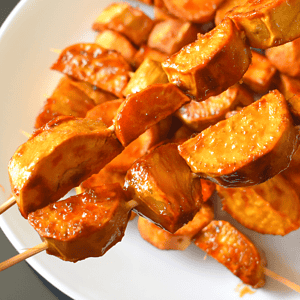
Kamote Que
Ingredients
- 2 lbs sweet potato Chopped in bite size
- 1 cup cooking oil
- 1 cup brown sugar
Instructions
- Start by peeling a sweet potato and cut it into small, bite-sized pieces.
- Heat some oil in a pan over a medium setting until it reaches a gentle 250°F.
- Carefully add your sweet potato pieces to the pan, then slowly increase the temperature until the oil is hot but not smoking, ideally between 350°F and 375°F.
- Fry the pieces until they turn a delicious golden brown, flipping them occasionally for an even cook.
- Once browned, sprinkle the pieces with brown sugar and keep frying, mixing them around until the sugar has turned into a yummy caramel coating.
- Your sweet potato bites are ready when the caramelized sugar has set. Take the pan off the heat and allow the bites to cool a bit. Serve them up on their own, or skewer them for a fun presentation. Enjoy your homemade treat!
